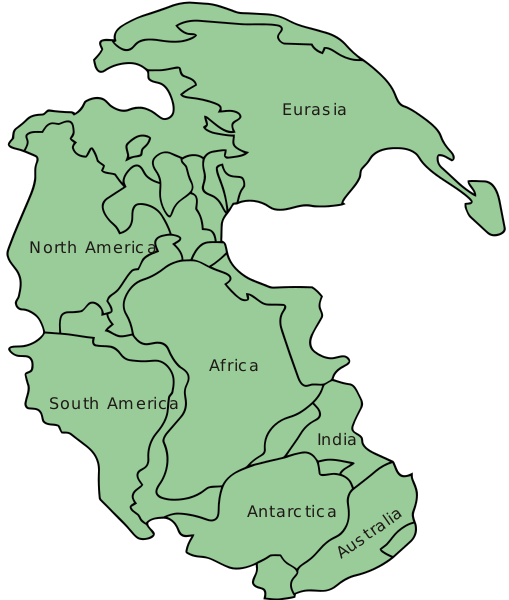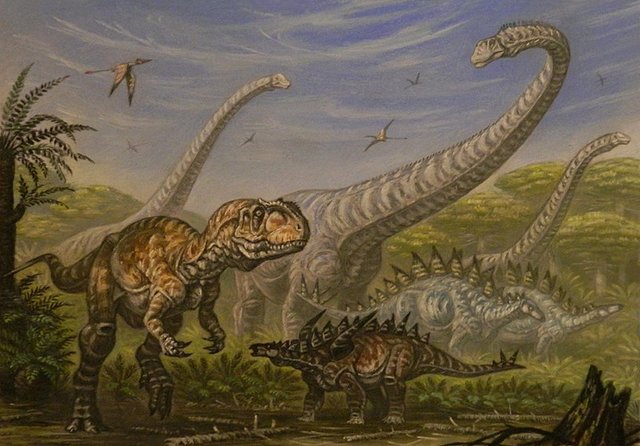Pangaea the Supercontinent
The earth we know today have seven continents which are Africa, Europe, Asia, North America, South America, Australia, Antarctica. What many don't know is that the earth originally didn't have seven continents, these seven continents were all part of one massive landmass referred to as a super-continent. The super-continent was known as Pangaea. Pangaea was a super-continent that existed many years ago in the Paleozoic and early Mesozoic era

Over 100 years ago, a scientist known as Alfred Wegener ( the originator of the continental drift scientific theory) after gathering several lines of evidence proposed that before the seven continents we have today, there existed an ancient super-continent. This notion was proposed in his publication titled "The origin of continents(Die Entstehung der Kontinente)". Years after he published this book he made published another to expand on his hypothesis and in these two publications he explained how the seven continents were all formed from a super-continent.
CONTINENTAL DRIFT THEORY
This theory explains continental drift which is the movement of the Earth's continents relative to each other. The continental drift theory also explains why similar rock formations are found on different continents.
This theory was disproved by many geologists for lack of mechanism and also Wegener could not provide a good model to explain the drifting apart of continents. Years later the mechanism required was provided by Arthur Holmes. Wegener's theory introduced the idea of a moving continents to the field of Geoscience and years after some scientists proved some of Wegener's theory right. It was in this theory that Wegener brought the idea of a super-continent.
EVIDENCE OF EXISTENCE
The first evidence given to support the idea of a super-continent was that the continents fits like a tongue and groove. If you take a proper view of the earth from maps showing the various continents you will find that this point in quite visible. If you observe the globe carefully you will notice that some of the continents appears to have been joined together at some certain point in time. One good example will be between the coastlines of Africa and South America, if you should visualize bringing them together, with just a little adjustment you will notice that they fit like some sort of pieces of a jigsaw puzzle. Also the eastern coastlines of North America seems to fit around portions of Africa.
Another evidence that was given was the similarity of fossils of animals found in South America and Africa. Wegener believed that identical animals could only be found in distant continents if these continents were joined together at a certain point in time.
Wegener during his observation found that there were matching rocks in the coastlines of south America and Africa, he just couldn't see this as one big coincidence because the continents were far apart so he came to the conclusion that the continents were once joined together.
Tropical fossils were found in the Antarctica which is located in the south pole and this was mysterious because the south pole is very cold and tropical fossils were not supposed to be found there. So the conclusion that Antarctica was formerly in a tropical region before if got drifted to the south pole was made.
- Perhaps the final evidence that solidified the continental drift theory and the existence of a super-continent is the Magnetic pole reversal. During the second world war, Henry Hess a Captain in the U.S. Navy was scanning the ocean using a technology known as Sonar to search for German submarines and during this search he discovered some sort of volcanic mountain in the middle of the Atlantic ocean which ran the entire length of the ocean but was not known to be existing. After the war they came back and took samples of the ocean floor and found evidence of magnetic pole reversal in the rock and this served as a DNA evidence that the continents were indeed Pangaea existed.
Life and Climate in Pangaea
The idea of one large landmass would make for different climatic cycles. Due to the large size of Pangaea, the interior portions had a much cooler and drier climate. Coal deposits found across the United States revealed that part of the ancient super-continent near the equator must have been a lush, tropical rainforest that is similar to the amazon jungle. From our knowledge of chemistry we already know that coal is formed in areas of swampy wetlands where groundwater is slightly above the topsoil. AND since coal forms when dead plants and animals sink into swampy waters it therefore explains that there was plentiful of life in this ancient super-continent. Climate models gotten from different researches suggest that the interior of Pangaea was extremely seasonal.
several animals existed in Pangaea and one of such animals was the Traversodontidae which was a family of plant eating mammals which is believed to include the ancestors of present day mammals. During the Permian period (which early on saw the collision of two great continents of the Paleozoic; Gondwana and Euramerica to form the super-continent Pangaea) insects such as beetles and dragonflies flourished. However the existence of Pangaea coincided with the Permian-Triassic extinction event which happens to be the worst ever mass extinction in history. During this period, most species that existed on earth went extinct. Also in Pangaea during the early Triassic period, the archosaurs (a group of animals which gave birth to crocodiles and birds) emerged and roughly over 200 million years back, dinosaurs also emerged on Pangaea including a group of largely carnivorous dinosaurs with air filled bones and feathers similar to birds known as theropods.

CYCLE IN HISTORY
Studies and observations have shown that it is unlikely for the current configuration of continents to be permanent. Over the course of history different super continents have been formed but later they result in the formation of new continents after splitting. Studies show that Australia is slowly closing in on Asia while the eastern portion of Africa is gradually drifting off from the rest of the continent.
REFERENCES

Thanks for reading, feel free to drop your comments below
The first evidence you mention is hard to ignore and is probably the strongest one.
Notice how South America and Africa have shapes that are a perfect match, like pieces of a puzzle. I don't believe something like that is just a coincidence. Pangea, in my opinion seems like something real.
It's quite remarkable actually and for me it's the most visible proof